UPSC Daily Current Affairs: 11 July 2024 | Current Affairs & Hindu Analysis: Daily, Weekly & Monthly PDF Download
GS2/Polity
SC Upholds Maintainability of West Bengal’s Suit Against CBI
Source: The Hindu

Why in news?
The Supreme Court upheld the maintainability of a lawsuit filed by the State of West Bengal against the Union Government. The suit accuses the Centre of "constitutional overreach" and violating federal principles by deploying the Central Bureau of Investigation (CBI) in the state without obtaining prior consent from the state government.
The Centre had argued that the Union government had no superintendence or control over the CBI.
About the Central Bureau of Investigation (CBI):
- The CBI is the premier investigating agency of India operating under the jurisdiction of the Ministry of Personnel, Public Grievances and Pensions, Government of India.
- It traces its origin from the Delhi Special Police Establishment (DPSE) Act, 1946, which regulates the CBI.
- As the DPSE Act is not passed by Parliament of India, CBI is created by an executive order of the government, hence not a statutory body yet and is exempted from the purview of the Right to Information (RTI) Act.
- Originally set up to probe cases of corruption in the government departments, CBI’s jurisdiction expanded to include several economic crimes, special crimes, cases of corruption and other cases.
Investigating powers of CBI are divided into:
- Anti-Corruption Division: It investigates cases against central government employees, public servants working under state governments (entrusted to the CBI by the state).
- The Economic Offences Division: It investigates financial crimes, bank frauds, money laundering, illegal money market operations, graft in PSUs and banks.
- The Special Crimes Division: It handles cases of conventional nature such as offences relating to internal security, espionage, narcotics and psychotropic substances, etc.
Types of consent:
- General consent: When a state gives a general consent to the CBI for probing a case, the agency is not required to seek fresh permission every time it enters that state in connection with investigation or for every case. It is normally given by states to help the CBI in the seamless investigation of corruption cases against central government employees in their states.
- Specific consent: When a general consent is withdrawn, CBI needs to seek case-wise (specific) consent for investigation from the concerned state government. If specific consent is not granted, the CBI officials will not have the power of police personnel when they enter that state, preventing the CBI from conducting a thorough inquiry.
Withdrawal of General Consent and its Impact:
- The withdrawal of general consent does not stop CBI probes in all cases. continues to probe in old cases until specifically taken back by the state government.
- Further, it continues to investigate cases that were given to it by a court order.
- The CBI can also challenge the decision (of withdrawal of general consent) in a court showcasing its progress of investigation in the case.
- The Supreme Court dismissed the Centre's initial objections against a lawsuit filed by West Bengal. The state challenged the CBI's authority to register and investigate cases in West Bengal after the state withdrew its general consent on November 16, 2018.
Key takeaways of the judgement
- The Supreme Court noted that the Union government is deeply involved with the CBI, as the agency can only investigate offences notified by the Centre under the Delhi Special Police Establishment (DSPE) Act
- According to Section 4 of the DSPE Act, the Central Vigilance Commission oversees offences under the Prevention of Corruption Act, while the Central government supervises all other matters.
- The court reminded the Centre that the DSPE Act requires the state's prior consent for CBI investigations within its jurisdiction.
- The agency (CBI) not being the ‘Government of India’
GS-III/Economy
MSMEs need funds for tech upgrades, green transition
Source: The Hindu
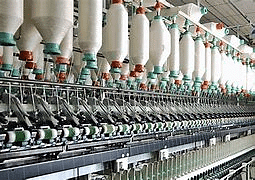
Why in news?
Union Minister for MSMEs Jitan Ram Manjhi outlined six strategic pillars identified to foster the growth of the MSME sector.
What are the 6 pillars for the growth of the MSME Sector?
Formalisation and Access to Credit: Promoting formalization of MSMEs to enhance their credibility and access to formal financial institutions. Improving access to credit through schemes like Credit Guarantee Fund Trust for Micro and Small Enterprises (CGTMSE).
Increased Access to Market and E-commerce Adoption: Facilitating MSMEs' access to domestic and international markets through initiatives like market linkages and export promotion schemes.
Higher Productivity Through Modern Technology: Encouraging MSMEs to adopt modern technologies and digital tools to improve productivity and efficiency.
Enhanced Skill Levels and Digitalisation in the Service Sector: Focusing on skill development and training programs to enhance the capabilities of the MSME workforce.
Support to Khadi, Village, and Coir Industry for Globalisation: Promoting traditional industries like Khadi and Coir by providing marketing support and international exposure.
Empowerment of Women and Artisans Through Enterprise Creation: Encouraging entrepreneurship among women and artisans through skill development and financial support.
How can Employment be raised?
Promoting MSME Growth: Supporting MSMEs through policies that enhance access to credit, market expansion, and technological modernization. Encouraging entrepreneurship and startups to create new job opportunities across various sectors.
Skill Development and Training: Investing in skill development programs aligned with industry needs to enhance employability. Collaborating with educational institutions and industry partners to bridge skill gaps and promote vocational training.
Infrastructure Development: Investing in infrastructure projects that create jobs directly and indirectly, such as construction, transportation, and utilities. Developing industrial clusters and economic zones to attract investments and generate employment in manufacturing and allied sectors.
Supporting Employment-intensive Sectors: Promoting sectors with high employment potential, such as tourism, agriculture, healthcare, and renewable energy. Encouraging initiatives that prioritize job creation and inclusive growth, particularly in rural and semi-urban areas.
Indian Government steps taken for MSME
Prime Minister Employment Generation Programme (PMEGP): This scheme aims to create employment opportunities through setting up of new micro-enterprises and to provide subsidies and credit support to MSMEs.
Credit Guarantee Scheme for Micro & Small Enterprises (CGTMSE): Provides collateral-free loans of up to ₹1 crore to individual Micro and Small Enterprises (MSEs).
Financial Support to MSMEs in ZED Certification Scheme: Provides up to 80% subsidy to MSMEs to inculcate Zero Defect and Zero Effect (ZED) practices in manufacturing.
A Scheme for Promoting Innovation, Rural Industry & Entrepreneurship (ASPIRE): Facilitates innovative business solutions, promotes entrepreneurship, and creates new jobs at the grassroots level.
Way to Green Transition and R&D (Way forward)
Financial Incentives and Soft Funds: Provide financial incentives, subsidies, and soft loans to MSMEs for adopting green technologies and practices. Support research and development (R&D) initiatives focused on sustainable solutions through grants and tax incentives.
Policy Support and Regulatory Framework: Develop supportive policies and regulatory frameworks that encourage MSMEs to integrate environmental sustainability into their operations.
Capacity Building and Technical Assistance: Offer capacity-building programs and technical assistance to MSMEs to enhance their knowledge and capabilities in green technologies.
Promotion of Green Products and Market Access: Promote green products and services through marketing campaigns and certification programs to increase consumer awareness and demand. Facilitate market access for MSMEs producing environmentally friendly products by creating platforms for showcasing and selling green innovations.
Mains PYQ
Economic growth in the recent past has been led by an increase in labour productivity. Explain this statement. Suggest the growth pattern that will lead to the creation of more jobs without compromising labour productivity. (UPSC IAS/2022)
GS3/Defence & Security
GRSE Accelerated Innovation Nurturing Scheme (GAINS 2024)
Source: Odisha Diary

Why in news?
The Defence Ministry has launched the "GRSE Accelerated Innovation Nurturing Scheme (GAINS 2024)" of Garden Reach Shipbuilders & Engineers Limited (GRSE) in Kolkata.
About GAINS 2024
- GAINS aims to address challenges in shipyards and promote technology development through startups nurtured in the country.
- It aligns with the ‘Make in India’ and ‘Start-up India’ policies of the Government of India.
Objective
- To seek solutions for shipyard-related problems and promote technological advancements.
Target Audience
- MSMEs and Start-Ups encouraged to develop innovative solutions.
Significance of the Scheme
- GAINS aims to strengthen maritime security and air defense through technological advancements.
- It leverages MSMEs and Start-Ups to achieve self-reliance in ship design and construction.
Various Defence Production Indigenisation Initiatives in India
ADITI Scheme (2024)
- The scheme targets the development of approximately 30 deep-tech critical and strategic technologies within the proposed timeframe.
Defence Acquisition Procedure (DAP) 2020
- Requires 50% indigenous content in procurement contracts.
Positive Indigenisation Lists
- Mandates domestic procurement for nearly 5,000 items.
Srijan Indigenisation Portal (2020)
- Lists over 34,000 items for indigenisation.
Domestic Procurement Budget
- Increased from 40% (₹52,000 crore) in 2020-21 to 75% (₹99,223 crore) in 2023-24.
Innovations and R&D Support
iDEX Initiative (2018)
- Involves MSMEs, start-ups, and academia in defence innovation.
iDEX Prime (2022)
- Provides grants up to ₹10 crore for high-end solutions.
Technology Development Fund (TDF)
- Funding increased from ₹10 crore to ₹50 crore per project.
GS3/Environment
Threats to Island Reptiles and Cacti Highlighted by IUCN
Source: DTE

Why in news?
The International Union for Conservation of Nature (IUCN) has issued an update on the threats faced by various reptile and cactus species due to invasive species and illegal trade.
Species highlighted by the IUCN
Ibiza Wall Lizard
- Status Change: Near Threatened → Endangered
- Reason for Decline: 50% population decline since 2010 due to invasive snake
- Location: Ibiza, Spain
Gran Canaria Giant Lizard
- Status Change: Least Concern → Endangered
- Reason for Decline: >50% decline since 2014 due to the introduction of California Kingsnake
- Location: Gran Canaria, Spain
Gran Canaria Skink
- Status: Critically Endangered
- Reason for Decline: 82% critically endangered, up from 55% in 2013
- Location: Atacama Desert, Chile
- Reasons: Illegal trade for ornamental purposes, climate change impacts
Back2Basics: IUCN Overview Table
Details:
- Founded: 1948
- Headquarters: Gland, Switzerland
- Mission: To conserve nature and ensure the sustainable and equitable use of natural resources.
- Focus Areas: Initially conservation ecology, now includes sustainable development issues
- Influence: Influences governments, businesses, and stakeholders
- Known for: The IUCN Red List of Threatened Species
- Categories of Extinction Risk: Nine categories from NE (Not Evaluated) to EX (Extinct)
- Threatened categories: Critically Endangered (CR), Endangered (EN), and Vulnerable (VU)
- Global Targets Indicator: Serves as a headline indicator for SDGs and Aichi Targets
- IUCN Green Status of Species: Assesses the effectiveness of recovery and conservation processes for species’ populations
PYQ:
Invasive Species Specialist Group’ (that develops Global Invasive Species Database) belongs to which one of the following organizations?
- The International Union for Conservation of Nature
- The United Nations Environment Programme
- The United Nations World Commission for Environment and Development
- The World Wide Fund for Nature
GS2/International Relations
India-Austria Bilateral Relationship
Source: First Post
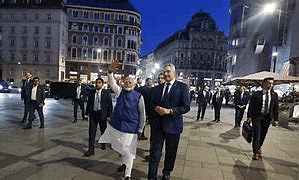
Why in News?
Prime Minister Narendra Modi met Austria's President Alexander Van der Bellen in Vienna to further expand bilateral cooperation in several sectors, including the environment and combating climate change.
India-Austria Relationship (Political, Economic, Cultural, etc.)
- India and Austria share a friendly and cooperative bilateral relationship that spans several decades.
- The partnership is built on mutual respect, shared democratic values, and a commitment to enhancing economic, cultural, and political ties.
Political Relations:
- Diplomatic Ties: India and Austria established diplomatic relations in 1949. Over the years, the relationship has been strengthened through high-level visits, bilateral agreements, and participation in international forums.
- Cooperation in Multilateral Platforms: Both countries collaborate in various international organizations such as the United Nations, emphasizing issues like climate change, sustainable development, and global peace.
Economic and Trade Relations:
- Trade Volume: Trade between India and Austria has been growing steadily, with both countries exporting and importing a variety of goods and services.
- Investment: Austrian companies have invested in India in sectors like engineering, renewable energy, and infrastructure. Similarly, Indian companies are exploring opportunities in Austria, particularly in IT and manufacturing.
Cultural and Educational Exchanges:
- Cultural Programs: Cultural exchanges are a vital part of the bilateral relationship. Initiatives like the Festival of India in Austria and Austrian cultural events in India help promote mutual understanding and appreciation of each other's heritage.
- Educational Cooperation: Many Indian students pursue higher education in Austria, benefiting from scholarships and exchange programs. Academic collaborations between universities in both countries are also on the rise.
News Summary (Key Outcomes of the Visit)
- Prime Minister Narendra Modi visited Austria from July 9-10, 2024, marking the first visit by an Indian PM to Austria in over 40 years.
- The visit coincides with the 75th anniversary of diplomatic relations between the two countries.
Key Points of the Visit:
- High-Level Meetings: PM Modi met with Austrian Chancellor Karl Nehammer and President Alexander Van der Bellen.
- Shared Values and Goals: Emphasis on democracy, freedom, international peace, and a rules-based order. Commitment to strengthening political, economic, and technological partnerships.
- Economic and Technological Cooperation: Focus on sustainable economic growth, green technologies, digital infrastructure, and innovation. Encouragement for business-to-business engagement and start-up collaborations.
- Political and Security Cooperation: Importance of a free and open Indo-Pacific region. Mutual commitment to counterterrorism and adherence to international law. Support for a peaceful resolution to the Ukraine conflict.
- Multilateral Cooperation: Reaffirmed commitment to multilateralism and UN reforms. Mutual support for each other's candidacies in the UN Security Council.
- Cultural and People-to-People Ties: Promotion of cultural exchanges, tourism, and academic collaborations. Recognition of the significance of yoga and Ayurveda in Austria.
- Climate and Sustainability: Joint efforts towards climate neutrality and the development of green hydrogen technologies. Focus on environmental technologies and sustainable economic practices.
- Future Visits and Invitations: Modi invited Chancellor Nehammer to visit India, which he accepted. The visit highlighted the robust and growing partnership between India and Austria, with a strategic approach to advance cooperation in various sectors.
GS-II/Polity
Muslim Women entitled to seek Alimony, says SC
Source: Financial Express
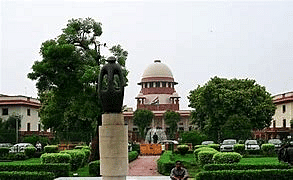
Why in news?
The Supreme Court has ruled that a divorced Muslim woman is entitled to seek maintenance from her husband under Section 125 of the Criminal Procedure Code (CrPC). The court asserted that any discrimination against Muslim women in matters of alimony under the secular laws of the country would be regressive and against gender justice, equality.
Key Points of the Judgment
- Legal Standing: There cannot be the disparity in receiving maintenance on the basis of the law under which a woman is married or divorced.
- Application of Section 125: Justice Nagarathna emphasized, "Section 125 of the CrPC cannot be excluded from its application to a divorced Muslim woman irrespective of the law under which she is divorced."
- Role of the 1986 Act: The judgment underscored that rights granted under the 1986 Act to receive maintenance during 'iddat' are in addition to, not in derogation of, those under Section 125 of the CrPC.
Muslim Women (Protection of Rights on Divorce) Act, 1986:
Purpose:
- To protect the rights of Muslim women who have been divorced by, or have obtained a divorce from, their husbands.
- To provide for matters connected with or incidental to their divorce.
Key Provisions:
Maintenance:
- During Iddat Period:
- A Muslim woman is entitled to a reasonable and fair provision and maintenance from her husband during the iddat period (a waiting period after divorce).
- Post-Iddat Maintenance:
- If she cannot maintain herself after the iddat period, she can claim maintenance from her relatives who would inherit her property on her death. If no relatives are available, the State Wakf Board is responsible for her maintenance.
- Mehr (Dower): The woman is entitled to the payment of mehr (dower) that was agreed upon at the time of marriage.
- Return of Property: The woman is entitled to all the properties given to her before or at the time of marriage or after the marriage by her relatives, friends, husband, or any other person.
- Rights of Children: The Act also provides for the maintenance of children born out of the marriage until they reach the age of two years.
- Application to Magistrate: A divorced woman, or someone acting on her behalf, can apply to a Magistrate for an order under the Act. The Magistrate has the authority to make orders for payment of maintenance, mehr, and return of property.
Criticisms and Issues:
- Limited Scope: Critics argue that the Act's provisions are limited to the iddat period and do not ensure long-term maintenance.
- Dependence on Relatives: Post-iddat maintenance depends on relatives, which might not always be practical or feasible.
- Role of Wakf Board: The effectiveness of the Wakf Board in providing maintenance has been questioned due to administrative and financial constraints.
- Violation of Right to Equality: The MWPRD Act has been criticized for creating discriminatory practices by limiting the maintenance period for Muslim women compared to women of other communities, thus violating the Right to Equality under Article 14 of the Constitution.
Context and Historical Perspective:
- Shah Bano Case (1985): The court referenced the landmark Shah Bano case, which affirmed Muslim women's right to maintenance under Section 125 of the CrPC.
- Danial Latifi Case (2001): It highlighted subsequent interpretations ensuring that the 1986 Act does not deprive Muslim women of rights under Section 125.
- Rejection of Restrictions: The court rejected restrictive interpretations that could hinder gender justice and emphasized the importance of providing adequate maintenance, not minimal amounts, to destitute Muslim women.
- Continuation of Section 144: The judgment noted that the Bharatiya Nagarik Suraksha Sanhita, 2023, which has replaced the CrPC, retains the older provision on alimony under Section 144.
- Maintenance Orders: Section 125 of the CrPC provides for the maintenance of wives, children, and parents who are unable to maintain themselves.
- Eligible Persons:
- Wife: Includes a divorced wife who has not remarried.
- Legitimate and illegitimate minor children.
- Adult children are unable to maintain themselves due to physical or mental abnormalities.
- Parents: Includes both father and mother who are unable to maintain themselves.
- Conditions:
- The person liable to pay maintenance has sufficient means.
- The person liable has neglected or refused to maintain the eligible person.
Significance:
- Social Justice: It aims to prevent vagrancy and destitution by ensuring that dependents are provided for.
- Secular Applicability: It applies to all religions and is not specific to any particular religion.
- Implications and Legal Precedent:
- Equality under Law: The judgment reinforces the principle that Muslim women have the same legal recourse as women of other faiths under Section 125 of the CrPC.
- Additional Remedies: It affirmed that provisions like the Muslim Women (Protection of Rights on Marriage) Act, 2019, do not exclude rights under Section 125.
PYQ:
[2020] Customs and traditions suppress reason leading to obscurantism. Do you agree?
[2019]Which Article of the Constitution of India safeguards one's right to marry the person of one's choice?
(a) Article 19
(b) Article 21
(c) Article 25
(d) Article 29
GS-III/Environment & Biodiversity
Indian Star Tortoises rescued from Malaysia
Source: MSN
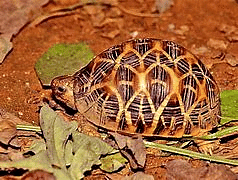
Why in news?
Malaysia has seized about 200 smuggled Indian Star Tortoises and Turtles in a major crackdown. The Indian star tortoise is the single most confiscated species of freshwater tortoise in the world, according to wildlife trade watchdog TRAFFIC.
Details
Habitat
- Found in Central and Southern India, West Pakistan, and Sri Lanka
- Typically resides in dry, open habitats such as scrub forests, grasslands, and rocky outcroppings
Threats
- Habitat fragmentation due to urbanization and agricultural practices
- Loss of genetic diversity due to hybridization
- 90% of trade occurs in the international pet market, according to the Wildlife Crime Control Bureau
Protection Status
- IUCN Red List: Vulnerable
- Wild Life Protection Act 1972: Schedule I
- CITES: Appendix I
GS-I/Indian Society
A Case of People Versus Population
Source: The Hindu

Why in news?
Since 1989, July 11 has been designated as World Population Day, marking the global population surpassing the five billion mark.
About Malthus Theory of Population
- Thomas Malthus’ Theory of Population, proposed in 1798, posited that population growth would outpace food production, leading to widespread famine and poverty.
- He believed population grows exponentially while food production increases linearly. However, advancements in agriculture and technology have prevented the catastrophic outcomes he predicted.
Present Scenario
Population Growth and Food Production:
- Despite significant population growth, currently estimated at 8.1 billion globally, advancements in technology and agriculture have enabled food production to keep pace. This disproves Malthus’ prediction of widespread famine due to population outstripping food supply.
India’s Demographics:
- India, the most populous nation with 1.44 billion people, has seen its annual population growth rate fall below 1%, with a total fertility rate (TFR) of 2, just below the replacement level. Economic growth has surged, with per capita GDP increasing sixfold from $400 to $2,400 over the past 27 years.
Poverty Reduction and Challenges:
- The percentage of Indians living below the poverty line has decreased from 43% to 11%. However, significant disparities persist, with certain states like Uttar Pradesh, Bihar, Madhya Pradesh, and Jharkhand accounting for 83% of the nation’s poverty. Climate change remains a critical challenge, disproportionately affecting poorer populations.
Changes in India
- Population Growth has Increased from 1 billion to 1.44 billion (44% increase). The Annual population growth rate decreased from nearly 2% to below 1%. Total Fertility Rate (TFR) has declined from 3.4 to 2, below the replacement level of 2.1.
- Per Capita GDP has rose sixfold from $400 to $2,400, signifying substantial economic growth. And percentage of people living below the multi-dimensional poverty line decreased from 43% to 11%.
- Increased from 61 years to 70 years, indicating improvements in healthcare and living standards.
- Climate change disproportionately affects poorer populations in developing countries like India. Inadequate housing, infrastructure, and resources make these communities more susceptible to the adverse effects of extreme weather events, such as floods, droughts, and heatwaves.
Agricultural Disruption:
- Unpredictable weather patterns and extreme climate conditions disrupt agricultural productivity, leading to food insecurity. This particularly impacts rural populations who depend on farming for their livelihoods, exacerbating poverty and malnutrition.
Migration and Displacement:
- Climate change-induced events, such as rising sea levels and severe weather, force people to migrate from their homes. This internal displacement puts additional strain on urban areas and exacerbates existing social and economic challenges, leading to overcrowding and increased competition for resources.
Agenda of Global South Population
Economic Growth and Poverty Eradication:
- Developing nations in the Global South prioritize economic growth to reduce poverty and improve living standards. The focus is on sustainable development, ensuring that economic progress is not compromised while addressing the immediate needs of their populations. India’s aim to achieve zero poverty within the next decade exemplifies this priority.
Sustainable Development and Climate Responsibility:
- The Global South advocates for a balanced approach to climate change, emphasizing the need for developed countries (with higher historical emissions) to take greater responsibility. The G-20 New Delhi Declaration (2023) highlights the importance of the circular economy, resource efficiency, and extended producer responsibility in achieving sustainable development without hindering economic growth.
A Pathway for the Most Populous Nation (Way Forward)
Balancing Economic Growth and Environmental Sustainability:
- India must continue prioritizing economic growth to alleviate poverty and improve living standards while integrating sustainable practices. Emphasizing circular economy principles, resource efficiency, and extended producer responsibility can help decouple economic growth from environmental degradation.
Reducing Poverty and Inequality:
- Targeted efforts to address regional disparities and uplift impoverished populations are crucial. Programs focusing on education, healthcare, and infrastructure development, particularly in states with high poverty levels like Uttar Pradesh, Bihar, Madhya Pradesh, and Jharkhand, are essential to ensure inclusive growth.
Climate Change Mitigation and Adaptation:
- India should implement strategies to mitigate climate change impacts, such as investing in renewable energy, enhancing disaster resilience, and promoting sustainable agriculture. While striving for net-zero emissions by 2070, India must ensure that climate actions do not compromise its economic growth and poverty eradication goals.
Mains PYQ
Critically examine whether growing population is the cause of poverty OR poverty is the mains cause of population increase in India. (UPSC IAS/2015)
GS3/Environment
Central India’s land-use patterns, roads fragmenting gaur & sambar populations, threatening genetic diversity
Source: The Hindu
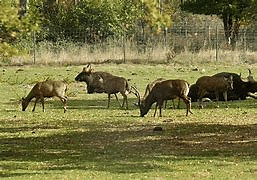
Why in news?
A recent study by the National Centre for Biological Sciences (NCBS) found that land-use alterations and road construction in central India affect the genetic connectivity of two prominent herbivores: the gaur and the sambar.
What is Genetic diversity?
Genetic diversity refers to the variety and variability of genetic material within a species or population, essential for adaptation, resilience to environmental changes, and long-term survival of organisms.
About National Centre for Biological Sciences (NCBS)
- NCBS is a premier research institute located in Bangalore, India that is part of the Tata Institute of Fundamental Research (TIFR) under the Department of Atomic Energy of the Government of India.
- The mandate of NCBS is to conduct fundamental research in the frontier areas of biology, ranging from the study of single molecules to ecology and evolution.
Impact of Habitat Modification
- The NCBS study underscores the significant impact of habitat loss and fragmentation on wildlife populations, particularly highlighting how expanding linear infrastructure like highways and railway lines disrupts animal movement and genetic connectivity.
Genetic Connectivity of Herbivores
- It is the first study in India to investigate the genetic connectivity of large herbivores, specifically the gaur and sambar, at a landscape scale. The research reveals how these species are affected differently by landscape features and human activities, influencing their genetic diversity and ability to adapt to environmental changes.
Conservation Urgency
- The study emphasizes the urgent need for conservation measures in fragmented habitats, such as Umred Karhandla Wildlife Sanctuary in Maharashtra, where small and genetically isolated populations of herbivores require targeted interventions to ensure their survival and genetic health.
Methodological Advances
- Using advanced genetic techniques like next-generation sequencing (NGS) and landscape genetics, the NCBS researchers demonstrated how these tools can provide crucial insights into population dynamics, genetic diversity, and the impacts of human-induced changes on wildlife populations.
Present Issues from Tiger reserves and Wildlife sanctuaries in MP and MH
Habitat Fragmentation and Connectivity
- Both states face challenges due to expanding linear infrastructure like highways and railway lines.
- These developments disrupt wildlife corridors essential for animal movement.
- Lead to isolated populations and reduced genetic connectivity.
Human-Wildlife Conflict
- Increasing instances of human-wildlife conflict pose a threat to both animals and human communities.
- Encroachment of habitat for agriculture and settlements results in conflicts over resources.
- Occasionally leads to casualties among both wildlife and humans.
Poaching and Illegal Wildlife Trade
- Tiger reserves and sanctuaries in MP and MH face challenges related to poaching and illegal wildlife trade.
- Endangered species are targeted for their skins, bones, and other body parts.
- Driven by demand in illegal markets.
Resource Extraction and Mining
- Mining activities near protected areas pose significant threats to the environment.
- Lead to habitat destruction, pollution, and disturbance.
- Affect the overall ecosystem health and biodiversity of these regions.
Climate Change Impacts
- Climate change effects like erratic weather patterns impact tiger reserves and wildlife sanctuaries.
- Changes can alter habitat suitability for wildlife species.
- Affect distribution, migration patterns, and ability to adapt to new environmental conditions.
Way Forward
Enhanced Habitat Connectivity and Protection
- Implement measures to mitigate habitat fragmentation caused by linear infrastructure.
- Create wildlife corridors over or under highways and railways for safe animal movement.
Integrated Conservation and Community Engagement
- Foster collaboration between local communities, conservation organizations, and government agencies.
- Address human-wildlife conflict and illegal activities like poaching.
Mains PYQ
How does biodiversity vary in India? How is the Biological Diversity Act,2002 helpful in the conservation of flora and fauna?
|
38 videos|5293 docs|1118 tests
|





















